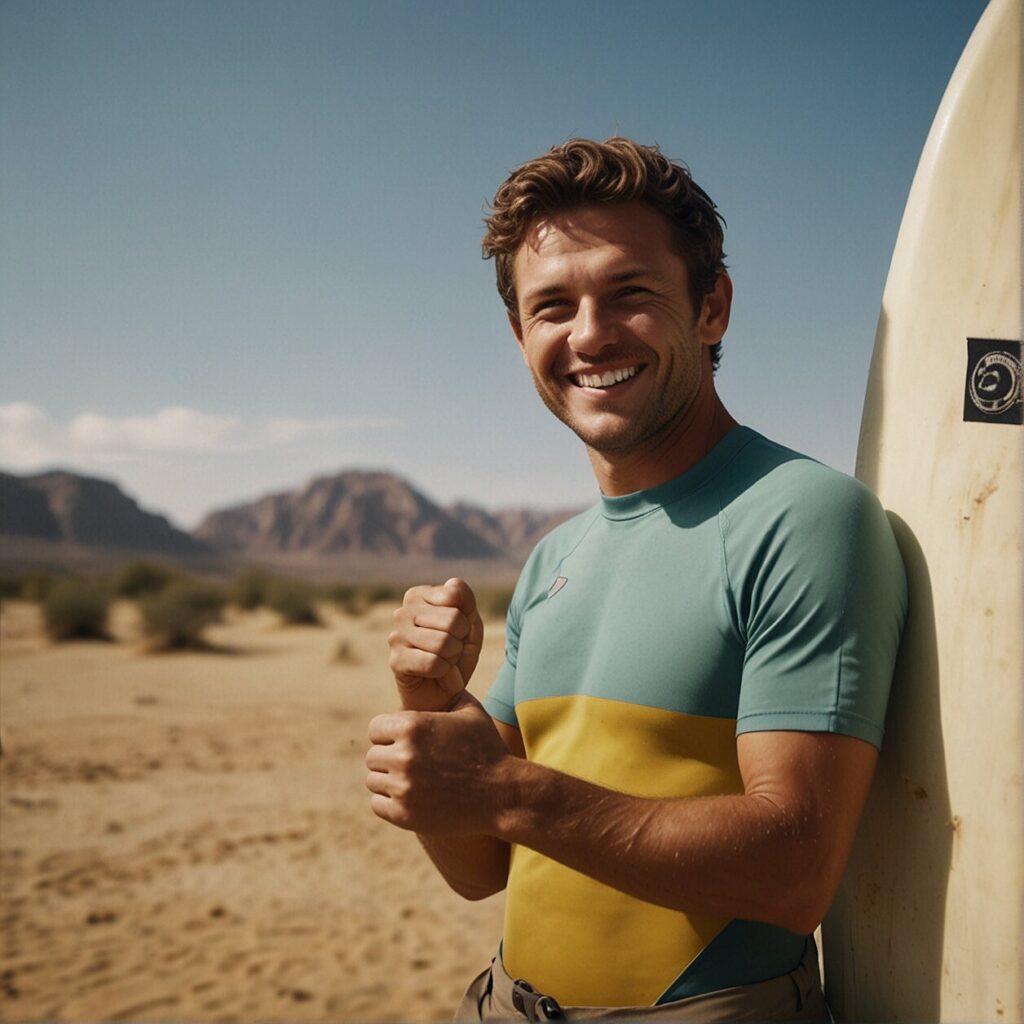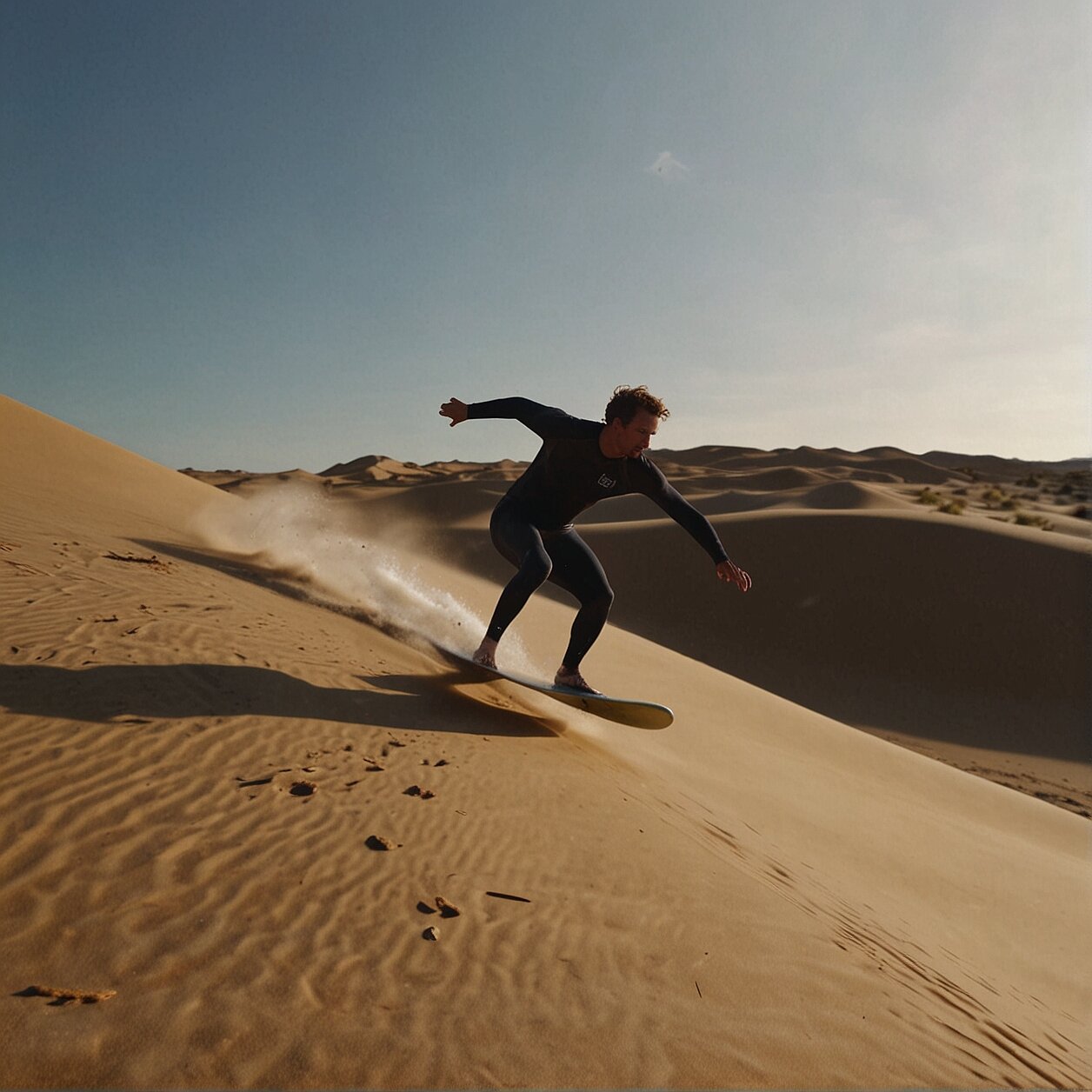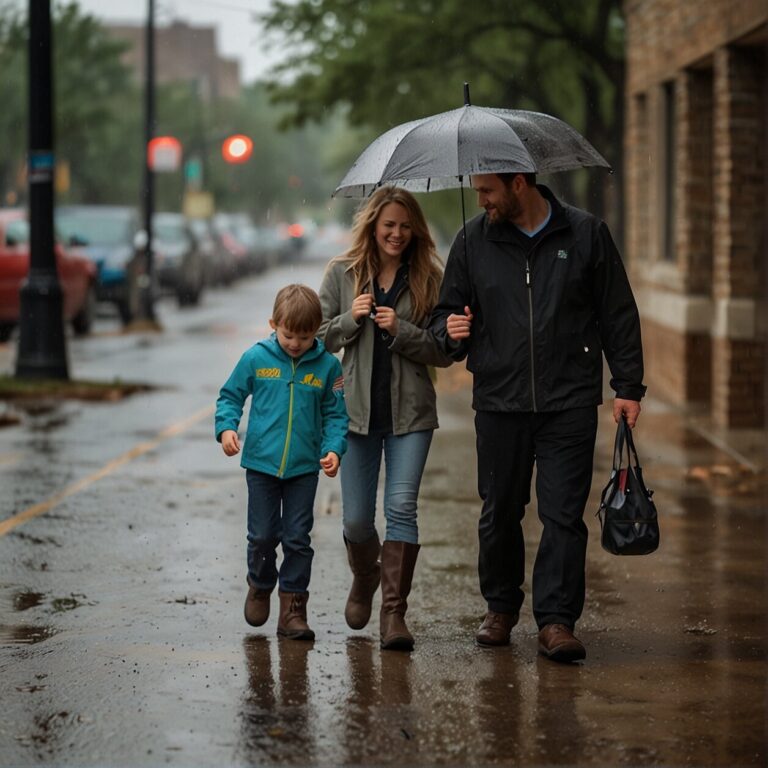Sandboarding in Peru’s Desert Dunes
Have you ever longed for an adrenaline rush that takes you out of your comfort zone, into the serene beauty of nature with a hint of thrill? Well, tuck your apprehensions away and gear up as we transport you into the tantalizing world of sandboarding with Peru’s mesmerizing dunes offering the ideal playground. A sport that combines the grace of snowboarding with the unpredictability of desert terrain, sandboarding has been swiftly gathering plaudits from thrill-seekers around the globe.
“Sandboarding is not just a sport, it’s walking into an adventure and riding out a story.”
While snow-capped peaks and icy slopes might be the conventional choice for board enthusiasts, there’s an unmistakable charm about pitting your wits against the golden dunes of Peru. As the warm sun beats down and the wind whispers tales of countless sandy escapades, its allure is tempting to both novices and seasoned veterans alike for an unforgettable experience.
Unveiling the Thrill of Sandboarding
Imagine carving your way down a golden dune, with a cloudless azure sky overhead and a wave of fine sand billowing in your wake. This is the magic of sandboarding – an adventure sport that sees participants riding down sand dunes instead of snowy slopes.
You might have heard sandboarding likened to a desert sibling of snowboarding. Indeed, both sports share similarities in equipment and techniques. However, sandboarding, with its unique tactile sensation, and its warm, dry environment, promises a completely different sensory experience.
So, why Peru? The vast, bounding dune-scapes of Peru, like those around Huacachina and Nazca, have a global renown, attracting riders from all corners. Gargantuan and graceful, these dunes offer both beginners and adept sandboarders a thrilling plunge into a world of sun, sand, and speed.
From the pace at which you glide over the warm sand to the unparalleled views atop mighty dunes, there’s no question that sandboarding is not just a sport—it’s a wild, adrenaline-fueled ride like none other. Intrigued? Buckle your sandboard bindings tight. You’re in for a truly exhilarating journey.

Getting Started: Your Guide to Sandboarding in Peru
Are you filled with anticipation, ready to embark on an unforgettable sandboarding adventure in the heart of Peru? The journey starts now, and we’re here to guide you every step of the way.
First things first, selecting the perfect board is paramount to your experience. Similar to snowboarding, you’ve got the choice between a traditional style board and the more off-piste “sand sled”. While the traditional board offers control and maneuverability, the sand sled offers pure velocity. It’s all about personal preference and adrenaline appetite, the choice is yours, adventurer.
In order to fully gear up for your sandboarding journey, you’ll need suitable attire. Breathable, light-colored clothing is optimal due to the scorching desert sun. A pair of high-ankle shoes will help keep sand out, making your ride much more comfortable. Remember, sunscreen is non-negotiable! The desert can be unforgiving and your skin will thank you for the protection.
Next on the agenda is to perfect your stance. Sandboarding relies heavily on balance – imagine yourself as a graceful flamingo on one leg. Start practicing at home before hitting the dunes. It’s always best to get a feel for the board on a flat surface before tackling the inclines and steeps of the Peruvian landscape.
Ready to get your feet sandy? Great! But remember, sandboarding is a physical sport and requires a reasonable level of fitness. To ensure you enjoy every moment, consider ramping up your cardio and strength training leading up to your trip. A fit body is a happy body, especially when it’s carving up the spectacular dunes of Peru.
We can’t wait to see you take on this journey and transform into a seasoned sandboarder, riding the dunes as if they were your second home. Go ahead, let Peru’s sand dunes make your wildest sandboarding dreams a reality.
Top Destinations: Sandboarding Hotspots in Peru
You’re probably wondering where to begin your sandboarding journey in Peru. Well, you’re in luck. Peru boasts numerous locations, each with its unique appeal for sandboarding thrill-seekers.
1. Huacachina
Known as the ‘oasis in the desert’, Huacachina is arguably the most famous sandboarding hotspot in Peru. This small village, nestled in the sands of the Ica desert, is surrounded by magnificent dunes that attract sandboarders worldwide. The sandboarding culture here is vibrant, and the dunes offer challenges for beginners and experienced riders alike.
2. Nazca
Nazca, primarily known for its puzzling Nazca Lines, is also a trending sandboarding destination thanks to its expansive, untouched dunes. The allure of Nazca lies in both riding down its massive sandhills and gazing at the awe-inspiring ancient geoglyphs sculpted into the earth. Sandboarding in Nazca gives you a unique mix of adrenaline rush and culture shock.
3. Cerro Blanco
Located near Nazca, Cerro Blanco is renowned as one of the highest sand dunes in the world. Avid sandboarders eager to test their mettle gravitate towards this spectacular spot. The trek to the top is demanding, but the exhilarating downhill ride is truly worth it.
Each of these destinations offers a unique sandboarding experience, complete with amazing views and thrilling descents. So, strap on your sandboard and get ready to explore the sandy side of Peru.
Mastering the Dunes: Essential Sandboarding Tips
Keep the thrill alive but remember, mastering the sport of sandboarding requires a combination of courage, balance, and proper technique. Whether you’re a seasoned boarder or a rookie hitting the dunes for the first time, these practical tips will help you glide over Peru’s sandy slopes with aplomb.
Getting To Know Your Sandboard: Before you tackle those towering dunes, familiarize yourself with your sandboard. It might look similar to a snowboard, but sandboards are specifically designed for the desert. They have a slick base to slide smoothly over the sand and are generally smaller, with foot straps instead of boots.
Understanding Sand: Sandboarding isn’t about brute strength or speed. It’s an art that calls for understanding the nature of sand. Unlike snow, sand doesn’t have a uniform consistency and might shift unpredictably beneath your feet. Pay heed to the terrain and use the changing conditions to your advantage.
Adjusting Your Stance: Feeling wobbly? Your stance might be the culprit. Generally, your front foot should be pointing forwards, and your back foot should be across the board. However, you can shift pressure from heel to toe, or lead with your shoulders as per your comfort. Remember, balance is key.
Controlling Your Speed: To regulate your speed while sailing down those intimidating dunes, sink down into a seated position, putting weight on your hind leg. If you need to stop, lean back and let your trailing hand touch the sand. Practice this a few times on a less steep slope before you tackle larger dunes.
Practicing Your Turns: Want to switch things up from simple ‘straight down’ sandboarding and start carving graceful arcs in the sand? To turn, shift your weight and point your lead shoulder in the direction you want to go. Again, practice makes perfect!
With time, practice, and the warm desert sun overhead, your proficiency will only increase. Happy sandboarding!

Sandboarding Safety: Staying Secure on Peru’s Steep Slopes
Sandboarding is an exhilarating sport but, like any extreme pastime, it comes with some inherent risks. Staying safe on the dunes should be your paramount concern. Striving for that perfect downhill glide? Make sure you’re equipped with proper gear. Apparel like sturdy boots, protective eye wear, long sleeves and hats are your first line of defense against scratches, sunburns, and flying sand particles.
Next on the safety list is your sandboard. Before hitting the dunes, ensure it’s waxed correctly; this minimizes risks associated with high-speed travel over unpredictable terrain. Also, a quick inspection of your board for any faults is advisable to prevent unwanted surprises.
Now that you’re equipped and ready, it’s time to consider the slope. Even experts can get thrown off by unexpected bumps or changes in the sand’s consistency. Start with smaller dunes and work your way up as your confidence grows. Patience is key here.
Finally, always remember to hydrate. Sandboarding under the Peruvian sun can take a toll on your body, and dehydration is a real threat. Carry ample water and remember to take breaks to avoid overheating. Remember, sandboarding is just as much about soaking in the stunning Peruvian landscapes, as it is about the sport itself.
Embrace the golden rule of outdoor sports — safety always comes first. A mix of careful preparation, responsible behavior, and respect for the dunes will ensure that your sandboarding adventure in Peru is thrilling, memorable, and, most importantly, safe.
FAQ’S
You’ve been introduced to the thrill of sandboarding, learned the basics, explored locations of the majestic Peruvian dunes, and even grasped some necessary safety tips. As thrilling as this can be, there might still be a dash of uncertainty or curiosity lingering in your mind. Our Frequently Asked Questions (FAQs) section will quench your thirst for knowledge, addressing all those burning questions about sandboarding in Peru that you’re dying to ask. Let’s dive in!
What are some tips for beginners in sandboarding?
There’s absolutely no need to fret if sandboarding is a new adventure for you. Starting out is generally kinder on the beginners than traditional snowboarding. However, a few tips can certainly give you an edge.
Firstly, it’s all about balance. Keep your weight centered over the board and bend your knees slightly to keep your center of gravity low. This technique aids in better control and stability while sandboarding.
Secondly, it’s important you always look in the direction you want to go – this advice may sound simple but it’s a key to steering your board. Your body automatically tends to follow your gaze.
Lastly, take the time to get familiar with your board. Walk around with it strapped to your feet, gradually moving up to sliding down small dunes. Progressing at your own pace helps inculcate confidence and a stronger understanding of the sport.
If possible, hire an instructor for your first few sessions. They can guide you with the right techniques, how to steer, slow down, and stop effectively. Remember, practice is always the key. Don’t expect to be mastering the dunes your first day out. Patience, perseverance, and positivity will have you smoothly gliding down those sandy slopes before you know it.
What should I wear for sandboarding in Peru’s desert?
In the sprawling and sun-drenched dunes of Peru, your choice of clothing will significantly impact your sandboarding experience. But let’s not fret, your wardrobe checklist is simpler than you may think.
First, consider the inner layer. Opt for lightweight, breathable fabrics like cotton or performance synthetics that wick moisture away. It’s important to stay cool and comfortable, especially under the blazing sun. A long sleeve shirt is preferable to protect your skin from both the harsh desert sun and any potential scrapes and grazes.
When it comes to your lower half, shorts are a common choice. However, these may leave your legs vulnerable to grazing during falls, or to sunburn. Thus, many choose to wear long, lightweight trousers instead. These can also double as a barrier against the sand, which can get everywhere – especially in your shoes – so think about investing in some gaiters.
Regarding footwear, it may seem counterintuitive, but closed-toed shoes are the way to go. Sand has a deceptively sharp bite, and you’ll spend much more time on your feet than you may initially believe. Sporty hiking shoes or robust trainers can provide the necessary traction and protection you need.
Lastly, don’t forget your headgear—a cap or a bandana is a must to shield you from the unforgiving sun. In addition, don’t forget a good pair of goggles or sunglasses for sun protection and to prevent sand from getting into your eyes.
How to handle sandboarding injuries?
While sandboarding is an adrenaline-filled adventure that promises sheer thrills, it comes with its risks. But don’t worry, as you’re not alone in handling potential injuries while sandboarding in Peru.
Firstly, the golden rule of any sport: prevention is always better than cure. Always wear protective gear such as helmets, knee pads, and elbow pads. These not only minimize potential injuries but also give you the confidence to experiment and get better.
If an unfortunate accident occurs, here’s what you should do.
Stay Calm and Assess the Situation
It’s crucial to remain calm after a fall. Take a moment to figure out what hurts, and if you’re able to move comfortably. If you’re unable to stand or there’s unbearable pain, get help immediately.
Get Professional Medical Assistance
You should never neglect an injury or try to push through the pain while sandboarding. When in doubt, seek immediate medical assistance. Luckily, many of Peru’s sandboarding hotspots have local medical facilities nearby for immediate response.
While it’s crucial to enjoy the thrill of sandboarding, it’s equally essential to prioritize your safety and well-being. With proper prevention and a measured response to injuries, your sandboarding experience can remain a memorable adrenaline rush rather than an unfortunate accident.
What are some local customs or rules I should be aware of when sandboarding in Peru?
When embarking on the thrill ride of sandboarding in Peru, it’s paramount to respect local customs and abide by the rules. This not only ensures a seamless experience for you, but also fosters admiration and respect from the local community.
Firstly, it’s important to understand that the desert is a sensitive ecosystem, maintained by intricate balances of weather, flora, and fauna. Refrain from littering and respect the wildlife. Also, adhere to marked paths to avoid disturbing the local habitat and remember: Next time, it may be your turn to carve through untouched sand landscapes.
As in control as you may feel while zipping down the towering dunes, keep in mind it’s not permitted to sandboard anywhere on your own in Peru. Use guided tours or work with registered organizations. They are not only legal, but they also employ local experts who have thorough knowledge of dunes and weather conditions. They can make suggestions on times ideal for sandboarding, which makes your experience safer and more enjoyable.
Lastly, remember to always follow instructions given by guides or trainers, especially during your first few rides. They’re not just meant for your safety, but also for the protection of other visitors and the environment. By respecting these rules and customs, you’ll ensure an unforgettable and enjoyable sandboarding experience while leaving no trace behind.
What are the costs associated with sandboarding in Peru?
Planning a sandboarding adventure in Peru doesn’t necessarily have to break the bank. Costs tend to vary depending on several factors, but we’ve got you covered.
The expenditure mainly includes the cost of equipment rental, instructor fees, and transit if applicable. Typically, you can rent a sandboard for about $10-$15 per day. If you’re new to the sport and prefer to take lessons, you’ll find professional instructors offering beginner courses starting at around $30 an hour. As for your ride to the dunes, if the sandy slopes aren’t near your chosen place of stay, you might require transportation which can cost anywhere between $20 and $50, depending on your distance from the dunes.
Value-added experiences like a full day guided tour can range from $50-$100. These tours often include equipment, instruction, transportation, and sometimes even meals. They’re a worry-free option for those looking to enjoy the day without the hassle of planning logistics.
Remember, investing in a good-quality sunblock and water bottle is essential too. These items may add to your budget, but they are non-negotiable considering the bright sun and high temperatures in Peruvian desert. Altogether, a typical day of sandboarding in Peru might cost you anywhere from $50 to $200, depending greatly on how luxurious or simple you want your experience to be.
Then again, cost should not deter you from embarking on this wild ride atop Peru’s silken dunes. After all, the thrill of flying down these massive mounds of sand is truly priceless!







